
Pottery, due to its relative durability, comprises a large part of the archaeological record of ancient Greece, and since there is so much of it, it has exerted a disproportionately large influence on our understanding of Greek society. The shards of pots discarded or buried in the 1st millennium BC are still the best guide available to understand the customary life and mind of the ancient Greeks. There were several vessels produced locally for everyday and kitchen use, yet finer pottery from regions such as Attica was imported by other civilizations throughout the Mediterranean, such as the Etruscans in Italy. There were a multitude of specific regional varieties, such as the South Italian ancient Greek pottery.

A lekythos is a type of ancient Greek vessel used for storing oil, especially olive oil. It has a narrow body and one handle attached to the neck of the vessel, and is thus a narrow type of jug, with no pouring lip; the oinochoe is more like a modern jug. In the "shoulder" and "cylindrical" types which became the most common, especially the latter, the sides of the body are usually vertical by the shoulder, and there is then a sharp change of direction as the neck curves in; the base and lip are normally prominent and flared. However, there are a number of varieties, and the word seems to have been used even more widely in ancient times than by modern archeologists. They are normally in pottery, but there are also carved stone examples.
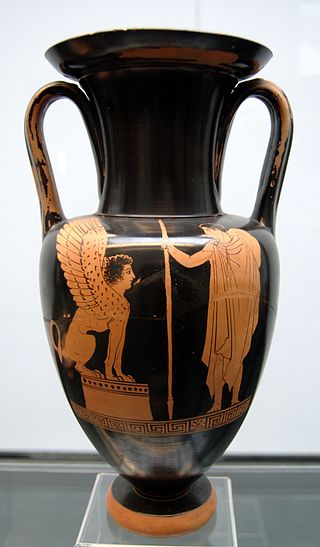
The Achilles Painter was a vase-painter active ca. 470–425 BC. His name vase is an amphora, Vatican 16571, in the Vatican museums depicting Achilles and dated 450–445 BC. An armed and armored Achilles gazes pensively to the right with one hand on his hip. The other hand holds a spear. On the opposite surface a woman performs libation.

Six's technique is the modern name for a technique used by Attic black-figure vase painters that involves laying on figures in white or red on a black surface and incising the details so that the black shows through. It was first described by the Dutch scholar Jan Six in 1888, and was given its English name by J. D. Beazley.
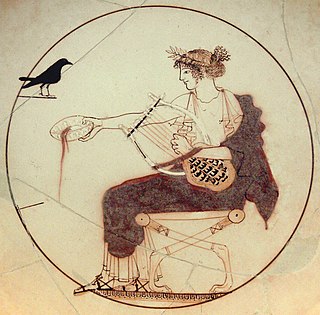
White-ground technique is a style of white ancient Greek pottery and the painting in which figures appear on a white background. It developed in the region of Attica, dated to about 500 BC. It was especially associated with vases made for ritual and funerary use, if only because the painted surface was more fragile than in the other main techniques of black-figure and red-figure vase painting. Nevertheless, a wide range of subjects are depicted.
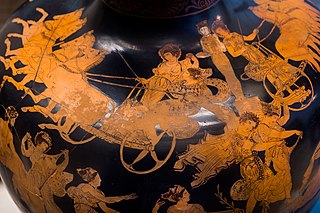
The Meidias Painter was an Athenian red-figure vase painter in Ancient Greece, active in the last quarter of the 5th century BCE. He is named after the potter whose signature is found on a large hydria of the Meidias Painter’s decoration, excavated from an Etruscan tomb. Eduard Gerhard first identified this inscription in 1839, and it was he who determined the scene on the vase was the rape of the daughters of Leukippos where previously it was thought to be the race of Hippomenes and Atalanta.

The Providence Painter is the conventional name given to a painter of the Attic red-figure style. He was active around 470 BC.
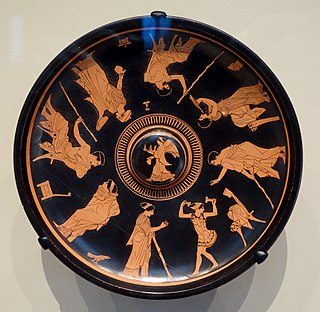
The Phiale Painter, also known as Boston Phiale Painter, was a painter of the Attic red-figure style. He was active around 460 to 430 BC. The Phiale Painter is assumed to have been a pupil of the Achilles Painter. In contrast to his master, he liked to depict narrative scenes. He painted several large calyx kraters, often with two registers of figures; unlike his master, he seems to have preferred larger vessels in general. This is shown by his white-ground works, which are not well known, but more expressive than those of the Achilles Painter. Apart from a number of lekythoi, he painted two chalice kraters in white-ground technique, a rarity at the time. His themes may be partially influenced by contemporary theatre. His preferred name for kalos inscriptions is that of Euaion, son of Aeschylus.

The Pan Painter was an ancient Greek vase-painter of the Attic red-figure style, probably active c. 480 to 450 BC. John Beazley attributed over 150 vases to his hand in 1912:
Cunning composition; rapid motion; quick deft draughtsmanship; strong and peculiar stylisation; a deliberate archaism, retaining old forms, but refining, refreshing, and galvanizing them; nothing noble or majestic, but grace, humour, vivacity, originality, and dramatic force: these are the qualities which mark the Boston krater, and which characterize the anonymous artist who, for the sake of convenience, may be called the 'master of the Boston Pan-vase', or, more briefly, 'the Pan-master'.

The Eretria Painter was an ancient Greek Attic red-figure vase painter. He worked in the final quarter of the 5th century BC. The Eretria Painter is assumed to have been a contemporary of the Shuvalov Painter; he is considered one of the most interesting painters of his time. Many of his best works are painted on oinochoai and belly lekythoi. His paintings often depict many figures, moving in groups across all available surfaces. He also painted such vessels as figure-shaped vases or head-shaped kantharoi. Even as the vase shapes he painted on are unusual, his themes are conventional: athletes, satyrs and maenads, and mythological scenes. There are also some careful studies of women. He also painted white-ground vases. A lekythos in New York shows a funeral scene, typical of white-ground painting: Achilles is mourning Patroclus; the nereids bring him new weapons. The Eretria Painter's drawing style influenced later artists, e.g. the Meidias Painter and his school.
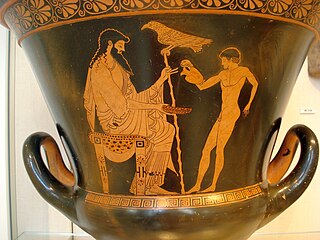
Eucharides Painter is the common nickname of an ancient Greek artist who decorated but did not sign Attic vases. Neither his real name, nor the dates of his birth and death are known. Presumably this artist was a pupil of the Nikoxenos Painter.

The Athena Painter was an Attic black-figure vase painter, active about 490 to 460 BC. His speciality were white-ground lekythoi painted in the black-figure style.
The Diosphos Painter was an Athenian Attic black-figure vase painter thought to have been active from 500–475 BCE, many of whose surviving works are on lekythoi.

The Reed Painter is an anonymous Greek vase painter of white-ground lekythoi, a type of vessel for containing oil often left as grave offerings. Works are attributed to either the "Reed Painter" or his atelier.

The Taleides Painter was an Attic vase painter of the black-figure style, active in the second half of the 6th century BC. His conventional name is derived from his close cooperation with the potter Taleides, many of whose vases he painted. He also worked for the potter Timagoras.
The Daybreak Painter was an Attic black-figure vase painter, active in the late sixth and early fifth centuries BC. His real name is not known.
The Beldam Painter was an Attic black-figure vase painter, active from around 470 to before 450 BC.
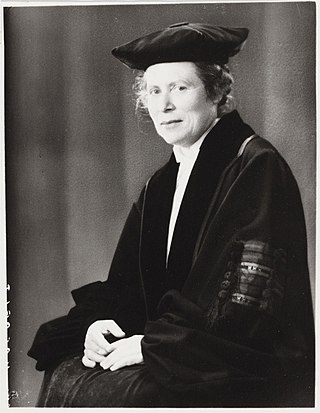
Caroline Henriette Emilie Haspels was a Dutch classical archaeologist.

Heracles and the Lion of Nemea is a lekythos which is held at the Louvre Museum, with the representation of the first of the labours of Hercules, the slaying of the Nemean lion. It is coming from Athens, dated around 500 – 450 BCE and it was bought for Louvre Museum at 1870. It was probably created from the shop of a Tanagran artist. According to Beazley and Haspels it is attributed to the Diosphos Painter.

Sappho Painter was an Attic black-figure vase painter, active c. 510–490 BCE.




















